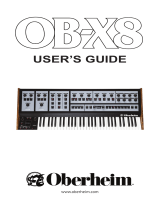
A Few Words of Thanks
Thank you for purchasing the OB-6. It’s an awesome-sounding synthesizer and
we’re very proud of it, and very proud to have been able to co-create it with my
old friend, Tom Oberheim.
I’ve known Tom since the late 1970’s when we both shared the heady experience
of creating and selling some of the very rst polyphonic synthesizers through
our respective companies, Sequential Circuits and Oberheim Electronics. Back
in those days, people were typically in either the Prophet or the Oberheim camp,
and though we were competitors, we were always friendly competitors, and have
remained good friends ever since.
Now, many years later, with the analog synth revival, Tom and I are again
making the instruments that we love. After I reacquired the Sequential brand and
released the Prophet-6 and saw how much people liked it, the Sequential gang
and I thought it would be fun to work with Tom to help bring back his classic
SEM-based polyphonic sound in a modern format. So we did. And the result is
the very synth that you’ve just unboxed.
The OB-6 takes the best qualities of Tom’s classic SEM-based synths and adds some
nice touches that the originals never had, such as stereo outputs, velocity and after-
touch sensitivity, dual digital effects, a polyphonic step sequencer, an arpeggiator, and
of course, MIDI. The result is a modern classic: Pure vintage analog tone with the
reliability of a state-of-the-art, modern instrument.
Working together to bring you the OB-6 has been a real pleasure. We hope you
enjoy it and make some great music with it!
Cheers,





















